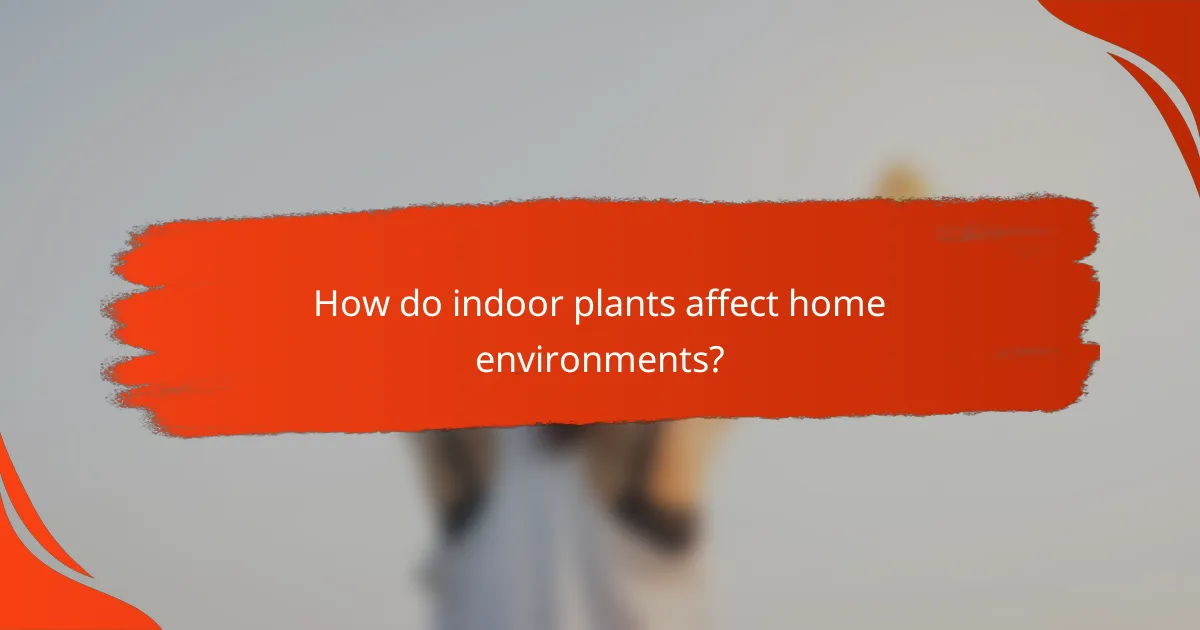Indoor plants play a vital role in enhancing air quality by filtering pollutants and increasing oxygen levels in our homes. By incorporating these green companions, you can enjoy numerous health benefits, such as reduced stress and improved mental well-being, while creating a more pleasant living environment.

How do indoor plants improve air quality in homes?
Indoor plants enhance air quality by filtering pollutants and increasing oxygen levels. They absorb carbon dioxide and release oxygen, contributing to a healthier living environment.
Reduction of indoor pollutants
Indoor plants can significantly reduce common pollutants such as formaldehyde, benzene, and trichloroethylene. These substances often originate from household items like cleaning products, furniture, and building materials.
By incorporating a variety of plants, you can create a natural filtration system that helps mitigate these harmful substances. Regularly rotating plants and ensuring they are healthy can maximize their pollutant-absorbing capabilities.
Increased oxygen levels
Indoor plants contribute to higher oxygen levels through photosynthesis, a process where they convert carbon dioxide into oxygen using sunlight. This increase in oxygen can lead to improved concentration and overall well-being.
Having several plants in a room can elevate oxygen levels noticeably, especially in smaller spaces. Aim for at least one plant per 100 square feet to optimize air quality benefits.
Specific plants for air purification
Some plants are particularly effective at purifying air, including the spider plant, peace lily, and snake plant. These species are known for their ability to absorb toxins and improve indoor air quality.
When selecting plants, consider factors such as light availability and maintenance requirements. Low-light plants like the pothos are ideal for darker areas, while succulents thrive in brighter conditions.
NASA Clean Air Study findings
The NASA Clean Air Study identified several plants that can effectively remove indoor air pollutants. This research highlighted the ability of certain plants to reduce volatile organic compounds (VOCs) in controlled environments.
According to the study, plants like the bamboo palm and rubber plant can remove up to 87% of indoor air toxins within 24 hours. Incorporating these plants into your home can significantly enhance air quality and promote a healthier atmosphere.

What are the health benefits of indoor plants?
Indoor plants provide numerous health benefits, including improved air quality, reduced stress levels, and enhanced mental well-being. By incorporating plants into your home environment, you can create a more pleasant and healthier living space.
Stress reduction
Indoor plants can significantly reduce stress by creating a calming atmosphere. The presence of greenery has been shown to lower cortisol levels, which is the hormone associated with stress. Simply looking at plants or spending time around them can promote relaxation and a sense of peace.
To maximize stress relief, consider placing plants in areas where you spend the most time, such as your living room or home office. Popular choices for stress reduction include peace lilies, snake plants, and lavender, all known for their soothing effects.
Improved mental well-being
Having indoor plants can enhance mental well-being by boosting mood and reducing feelings of anxiety and depression. Studies suggest that interacting with plants can lead to increased feelings of happiness and satisfaction. The act of caring for plants can also provide a sense of purpose and accomplishment.
To improve your mental health, choose plants that are easy to care for, such as pothos or spider plants. Regularly tending to these plants can create a routine that fosters mindfulness and emotional stability.
Enhanced productivity
Indoor plants can enhance productivity by improving focus and concentration. Research indicates that having plants in workspaces can lead to higher levels of creativity and efficiency. The presence of greenery can reduce fatigue and increase overall job satisfaction.
For optimal productivity, consider placing plants like succulents or ferns on your desk or in meeting areas. These low-maintenance options can thrive in various lighting conditions and require minimal care, allowing you to reap the benefits without added stress.

Which indoor plants are best for health and air quality?
Indoor plants that enhance health and air quality include species known for their air-purifying properties. These plants can help remove toxins from the air, improve humidity, and contribute to a healthier living environment.
Spider plant
The spider plant is renowned for its ability to filter out formaldehyde and xylene, making it a popular choice for improving indoor air quality. This hardy plant thrives in a variety of conditions, requiring minimal care and indirect sunlight.
To care for a spider plant, water it moderately, allowing the soil to dry out between waterings. It can grow well in both pots and hanging baskets, adding visual interest to your home.
Peace lily
The peace lily is effective at removing harmful pollutants like ammonia, benzene, and formaldehyde from the air. Its elegant white blooms and glossy leaves make it a beautiful addition to any room.
Peace lilies prefer low to medium light and should be watered when the top inch of soil feels dry. Keep in mind that they are toxic to pets if ingested, so placement should consider household animals.
Snake plant
The snake plant, also known as mother-in-law’s tongue, is particularly resilient and can survive in low light and drought conditions. It is effective at filtering out formaldehyde, xylene, and toluene, making it a great air purifier.
Water the snake plant sparingly, as overwatering can lead to root rot. This plant is ideal for beginners and can be placed in various locations around the home, including bedrooms and living rooms.
Aloe vera
Aloe vera is not only known for its soothing gel but also for its air-purifying capabilities. It helps remove formaldehyde and benzene, contributing to a healthier indoor atmosphere.
This succulent thrives in bright, indirect sunlight and requires infrequent watering. Aloe vera is also safe for pets, making it a practical choice for households with animals.

How do indoor plants affect home environments?
Indoor plants significantly enhance home environments by improving air quality, boosting aesthetics, and contributing to overall well-being. They can create a more inviting atmosphere while also providing practical benefits like humidity control and noise reduction.
Improved aesthetic appeal
Indoor plants add vibrant colors and textures to living spaces, making them more visually appealing. They can serve as focal points or complement existing decor, transforming a dull room into a lively sanctuary.
Choosing the right plants can enhance the style of your home. For example, large leafy plants like fiddle leaf figs can create a dramatic effect, while smaller succulents can fit neatly on shelves or desks.
Humidity regulation
Plants naturally release moisture into the air through a process called transpiration, which can help maintain comfortable humidity levels indoors. This is particularly beneficial in dry climates or during winter months when heating systems can lower indoor humidity.
Maintaining humidity levels between 30% and 50% is ideal for comfort and health. Consider placing several plants in a room to effectively increase moisture levels, especially in areas like bathrooms or kitchens where humidity is often welcomed.
Noise reduction
Indoor plants can help absorb sound, making spaces quieter and more serene. Their leaves and stems can act as natural sound barriers, reducing echoes and background noise in homes.
To maximize noise reduction, opt for larger plants with dense foliage. Placing these plants strategically near windows or walls can enhance their sound-absorbing qualities, contributing to a more peaceful environment.

What criteria should you consider when choosing indoor plants?
When selecting indoor plants, consider factors such as light requirements, maintenance level, and space availability. These criteria will help you choose plants that thrive in your specific home environment and suit your lifestyle.
Light requirements
Different indoor plants have varying light needs, which can range from low to bright indirect light. Assess the natural light available in your space to determine which plants will flourish. For instance, snake plants and pothos do well in low light, while succulents and cacti require bright light.
To ensure your plants receive adequate light, observe their growth patterns. If a plant stretches towards the light source or shows signs of yellowing leaves, it may need more light. Consider using grow lights if your home lacks sufficient natural light.
Maintenance level
Indoor plants vary in their maintenance requirements, from low-care options to those needing regular attention. If you have a busy lifestyle, consider low-maintenance plants like ZZ plants or peace lilies, which require minimal watering and care.
For higher-maintenance plants, such as orchids or ferns, be prepared to invest time in their care, including specific watering schedules and humidity levels. Evaluate your commitment to plant care before making a selection to avoid frustration.
Space availability
Space availability is crucial when choosing indoor plants, as some species can grow quite large while others remain compact. Measure the area where you plan to place your plants to ensure they have enough room to thrive without overcrowding.
Consider vertical gardening options if space is limited. Hanging plants or wall-mounted planters can maximize your space while still allowing you to enjoy greenery. Additionally, choose pots that fit your available space and complement your home decor.


